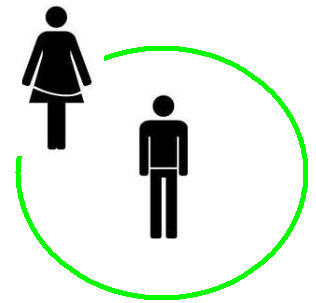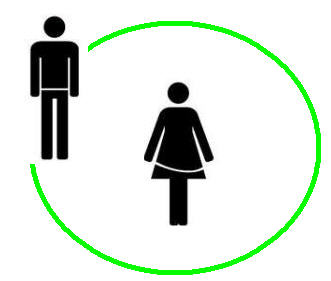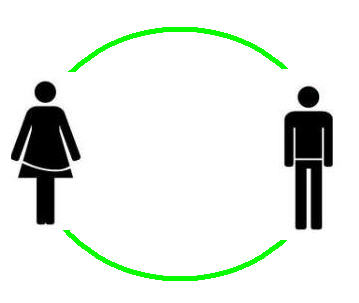Class Notes: October 2011
These are the class notes for October 2011 Tango classes in Berkhamsted.
- 2nd October: The cross and offset embrace
- 9th October: Ochos and Giros
- 16th October: Circles and social dancing
- 23th October: Dancing tips - traditional and nuevo
- 30th October: Crosses and decorations
2nd October: The cross and offset embrace
This was the first of the "Common Patterns" classes, looking at the cross step.
Beginner class: The cross
We looked at leading the Cross, starting out by walking in an offset position ("4 track"), then leading a cross from there.
We then moved on to leading a cross from a walk, and looking at possible sequences for a cross.
A Sequence!
We did a standard entry to a cross step:
Leaders: sidestep left (to outside) > 2 forward steps > collect (and lead a cross step) > lead a weight change
Followers: sidestep right > two back steps > cross when led (left foot over right foot) > change weight to front (left) foot
Key points
- When leading the actual cross, don't pull your partner to the side, simply straighten out your body - "close your chest"
- Followers: similarly, don't turn to the side, but keep facing your partner when you cross.
- Cross movements should feel natural. So leaders, don't "expect" a follower to cross at a certain point. And followers, don't anticipate a cross - only cross when the step is led.
- Followers, after you cross, change your weight to the crossed foot - this change of weight should be led, but for the moment, you're best off just doing it, as that's what you'll need to do 99% of the time anyway.
- Followers, take your time to cross - the movement should be natural, at the same speed that you walk back normally.
Important note: the above is simply a sequence - it's not necessary to do this to lead a cross. If you look at the video here, that shows you some alternatives.
More
Improver class: Crosses in close (offset) embrace
We introduced the concept of using the "offset" or "V" embrace, and the advantages of an offset embrace with regards to leading movements such as crosses.
We then looked at a cross sequence using a V embrace:
- Sidestep (man left, lady right), then man changes weight to right foot - lady does not change weight.
- Man steps forward on left, lady back on left (crossed system)
- Man steps forward on right and leads cross, lady back on right then cross left over right foot
- Pauses whilst lady changes weight, then steps forward on left as lady steps back on her right (parallel system)
The advantage of this sequence and embrace is that there's minimal "twisting" involved; it should feel quite natural.
Key points
- An offset embrace is good for some things (like the cross!), but bad for others.
- It's probably best to avoid chopping-and-changing embraces during a track.
More information: see the LearningTango Syllabus topic on common patterns.
9th October: Ochos and Giros
Beginner class: Ochos
Ochos are simply steps and pivots. If you step forward (on the inside leg), then it's a forward ocho, if you step back (on the outside leg), it's a back ocho. So far, so simple...
We worked on forward ochos, working on leading with the chest (pivotting without stepping), and also walking "in a circle". To expand on this a little, for a forward ocho, do not simply walk in a straight line, ending up further away from your partner - or, this is what not to do:

Instead, what you should do is to think of an ocho as being a step around your partner, in a circular manner. You're tracing the first part of a circle around your partner.
For example:

This means you'll be keeping yourself at the same distance from your partner at all times during the step.
More information: see the LearningTango Syllabus topic on forward ochos.
Improver class: Giros
A "Giro" (pronounced "Hero") is a turn. Typically, the leader stands in place, and the follower is led to walk in a circular path around the leader (either clockwise or anticlockwise).
We considered the giro as a continuation of the "walk around the partner in a circle" concept we introduced with the ocho. We looked at leading a giro using chest rotation, and about following it in a standard forward-side-back-side pattern, in both directions.
We also added a giro-with-barrida (sweep) pattern.
Key points for the follower:
- Dissociation - keep your upper body facing the centre of the point you're walking around.
- Collect your legs in between every step.
- Don't overtake leaders - take your time on the walks
The lead is to start rotating around. This can be done from any point, in either direction.
Key points for the leader
- The rotation is a smooth and continuous motion, not a step-stop-step-stop movement.
- There's no mandatory footwork - feel free to simply shuffle around - but don't move your feet too much, as you want to try to keep a single rotation point for your follower to walk around.
- To lead the rotation, open up the shoulders whilst rotating - keep the chest moving ahead of the feet.
- Keep upright - balls of the feet.
More
A Barrida movement within a Giro
We briefly did a barrida as part of a giro movement, sweeping the sidestep after the backstep of a giro.
Key points:
- Leaders, don't force the move - no pushing of feet please. The feet simply happen to be in contact when you lead a step - as normal - with the body.
- Followers, similarly, move your feet as normal when led to do so - ignore the fact that the feet are touching; don't react differently based on this.
Note: barridas are not essential parts of Tango dancing, so don't panic if you don't get the hang of them immediately. Also, this step is simply an example of a class of steps; it's not something vital to memorize.
Examnple video of barridas and giros:
More
- More information about barridas
- More information: see the LearningTango Syllabus topic on giros.
16th October: Circles and social dancing
Beginner class: Circular movements
We carried on with last week's topics, looking at the concept of walking around our partners in a circular manner, and the changing shapes of movements such as ochos, depending on the movement of the leader.
We looked at the different possibilities for the "axis" or centre of rotation:
- The leader - for example, a giro movement.
- The follower - for example, a carousel movement
- In between - when both partners are walking around a central point

Woman walks around man

Man walks around woman

Woman and man walk around central point
For the third possibility, we examined "mirror ochos" - both partners taking forward ochos at the same time, effectively both walking around a single spot. This is a good exercise for both leaders and followers, as it helps balance and dissociation.
Key points:
- Don't walk "away" from your partner, think that you're both walking "in a curve" around a circle.
- When stepping (for both partners) work to keep your chest facing your partner at all times
We then extended this "mirroring" to giros, with both partners doing the same pattern, both walking around a central point (using a shared axis of rotation).
For more information: see the LearningTango Syllabus topic on giros.
This concludes the "Common Patterns" section of the syllabus.
Improver class: Social dancing
We then started looking at social dancing, in close embrace.
We covered Basic Tempo Changes, including single time, double-time and half-time movements.
We danced to a few tracks (repeated), working on adding in pauses and double-time movements to this music.
We did a little "cabeceo role-play", separating men and women and asking / accepting / refusing a dance using the cabeceo / mirada.
We finally briefly covered Basic Etiquette, including:
- Remember the "3-dance" rule - "tandas" are groups of dances separated by interlude music ("Cortinas").
- "Thank you" means "Goodbye".
- Respect the other dancers on the floor.
More information: see the LearningTango Syllabus topic on dancing.
23rd October: Dancing tips - traditional and nuevo
The theme for today's classes was social dancing, to both traditional and nuevo music styles.
Beginner class: traditional
We spent some time working on dancing in close embrace, to traditional music, emphasizing the line of dance and musicality areas.
Exercise: dancing in a small space
We blocked off most of the dance floor, forcing the class to dance in a very small area. The aim of this exercise is to get the feeling of dancing very close to other couples, to work on the awareness of other dancers on the dance floor.
Similarly, we then did a "train" - dancing around the floor, but lined up close together - to simulate the feeling of a milonga.
Key points:
- Obey the line of dance.
- Don't overtake, it's not a race.
- Followers: be careful with your heels, they can be dangerous weapons.
We then looked at navigating around corners, using either simple pivots or rocksteps.
We finished with a slightly more ambitious way to go round corners, using an Ocho Cortado.
Sequence: mini-Ocho-Cortado
The Ocho Cortado - literally, a "Cut ocho" - is typically taught as a sequence, but we focussed on the "cut" part of the movement - a chopped / pulsed sidestep, followed by a lead to a cross, then a step out.
This sequence goes as follows (from the leader's point-of-view):
- Both take a "pulse" step (no weight transfer) to the right hand side
- Leader transfers weight to the right foot, whilst simultaneously pivotting to the left and leading the follower to cross her left foot over the right
- Both step off (having pivotted 90 degrees anti-clockwise).
Video Recap
Other example videos
Here's an example of the full Ocho Cortado pattern (in open embrace):
Here's another example, in close embrace, and with the instructions in Spanish for added authenticity (subtitled)
Improver class: nuevo
We then switched to dancing "nuevo style", to more modern musical styles.
The main emphasis here was on dancing based around pivot-style movements. So the progression is not so strict, the embrace is more open (or at least, more flexible), and the steps are often larger.
As we discussed in last week's class, typical movements are "circular", so we emphasized this type of movement and feeling during the dancing.
Sequence: Media Luna and Parada
- Leader sidestep left, follower sidestep right (leader takes a slightly larger sidestep to end up offset)
- Leader steps forward onto the right foot, to the outside of the follower - the follower simultaneously steps back left and collects
- leader starts to pivot anti-clockwise - follower sidesteps to (her) right and collects
- Leader continues to pivot - follower steps forward and collects, continuing walking around the leader.
- As follower steps forward, leader slides right foot round to touch the follower's left foot
- Leader then reverses the direction, pivotting the follower to step over the leader's right foot - leader slides his right foot again to touch the followers right foot
- Leader then reverses the direction again, and again pivotting the follower to step over the leader's right foot
- Leader then continues the anti-clockwise rotation, to finish off with a giro movement.
Video Recap
Other example video
Here's an example of a Media Luna being used (with a turn):
More information: see the LearningTango Syllabus topic on tips for leaders and followers.
30th October: Crosses and decorations
Beginner class: ambidextrous crosses
We worked on a series of exercises where both the man and the woman can cross on either side.
The idea of this one is to get the men used to being able to lead a cross on either side, and to also being able to cross ourselves.
Improver class: decorations for men and women
Adornments ("Adornos" / "Embellishments" / "decorations" - all the same thing) are general actions which make the dancing look and feel better - they're the icing on the cake.
A key point about decorations is exactly that - they're icing, they're not the cake. So these should not ever interfere with the connection or the basic step. If you're not comfortable doing the basic step, then don't do decorations.
We covered decorations for the follower and the leader, and we then danced to several tracks to different types of music, fitting the decorations in to the music.
Leader decorations: Sidestep with golpecito / amague
Some decorations for the leaders, based on a sidestep-left-then-forward-step combination.
Variation 1: Golpecito (tap):
- Step to the left
- Pause
- Leaders tap right toe (several times if required :) )
- Step forward on right
Variation 2: Amague (hook):
- Step to the left
- Hook right foot behind left
- Step forward on right
Key points:
- Keep the taps small and balanced - movement is mainly below the knees.
- Don't spend too long on them.
- Followers, do nothing whilst the leader does his decoration.
Follower Decoration: Hook step ("Amague" / "Saludo")
For any forward or back step, followers can "hook" their feet into a back or forward cross position, before taking the step.
We worked on this with forwards and back ochos - hooking behind in forward ochos, hooking in front with back ochos.
Here's an example of an Amague as used on a back ocho: